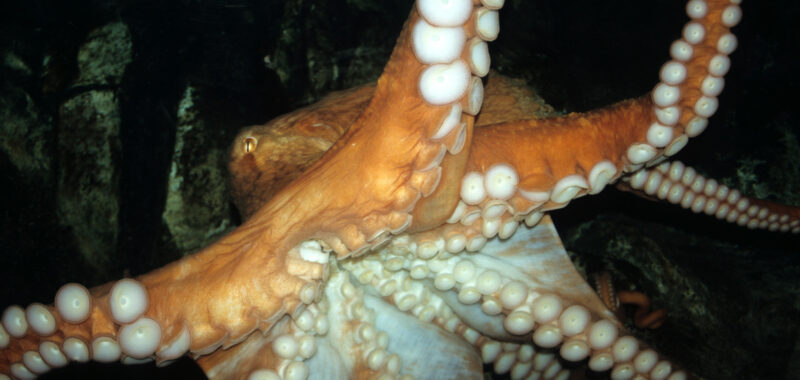There are many remarkable things about octopuses—they’re famously intelligent, they have three hearts, their eyeballs work like prisms, they can change color at will, and they can “see” light with their skin. One of the most striking things about these creatures, however, is the fact that each of their eight arms almost seems to have a mind of its own, allowing an octopus to multitask in a manner that humans can only dream about.
At the heart of each arm is a structure known as the axial nervous cord (ANC), and a new study published January 15 in Nature Communications examines how the structure of this cord is fundamental to allowing the arms to act as they do. Cassady Olson, first author on the paper, explains to Popular Science that understanding the ANC is crucial to understanding how an octopus’s arms work: “You can think of the ANC as equivalent to a spinal cord running down the center of every single arm.”
Olson explains that “there are many gross similarities [between the ANC and vertebrates’ spinal cords]—there is a cell body region, a neuropil region, and long tracts to connect the arms and brains in each.” This means that an octopus’s arms are very different to human limbs, or those of other vertebrates; if anything, Olson says, they are most analogous to the prehensile tails found in some vertebrates: “From a movement perspective, I’ve [often] thought of the similarities between a vertebrate tail and an octopus arm.”
However, unlike a tail, octopus arms are boneless. Technically, they are a type of structure called a “muscular hydrostat,” composed only of muscle, connective tissue, and nervous tissue. (Another example of such a structure, Olson notes, is the human tongue.) This provides them far more freedom of movement than a tail, and allows octopuses to demonstrate remarkable dexterity. And, of course, each arm is studded with suckers, all of which an octopus can control independently—to the extent of changing individual suckers’ shape as required—and all of which can also smell and taste as well as feel.
It’s no surprise, then, that octopus arms are laden with neurons—indeed, as the paper points out, there are “more neurons found distributed across [an octopus’s] eight arms than in the brain.” This provides each arm with a degree of autonomy, allowing an octopus to use some arms to perform one task while also carrying out another, entirely different activity with other arms. It’s not uncommon, for example, to see an octopus using several arms to move itself across the ocean floor while cracking open a shell with two others. Each arm can also react independently to stimuli without involving the central brain. (There’s a rather gruesome demonstration of the latter fact: “Amputated octopus arms,” Olson says, “will still move around on their own without commands from the brain.”)
The degree of autonomy displayed by each arm, says Olson, “indicates that … much of the circuitry for basic movements is contained within the ANC itself.” Exactly how this circuitry was distributed, however, was unknown, and the key finding in this new study is that the ANC is divided into segments that run lengthwise along the arm.
It’s this modular structure, Olson says, that allows some of the work involved in controlling the arm’s movements to be delegated to the neurons in these segments, rather than everything being controlled by the octopus’s brain. “The segmentation we see in the cell body layer of the ANC can be thought of as repeated processing units along the ANC,” she says. “This provides the benefit of local processing for arm motor control, subdivided into smaller units, rather than a central command sent from the brain through a bundle of nerve fibers.”
While such segmented structures aren’t unique to octopuses—worms, for instance, have entirely segmented bodies—Olson says that a key difference between octopus arms and creatures like worms is that “the segmentation we describe in cephalopod arms pertains mostly to [the] nervous system.”
The inner workings of octopus arms might seem a world away from everyday human life, but there’s a surprising amount of real-world utility to this research. The field of “soft robotics”, which involves the construction of robots from soft, pliable substances rather than the chrome-polished steel of popular imagination, has taken plenty of inspiration from octopuses. Designers in this field have often used segmented designs for structures that resemble octopus arms, and Olson says that finding an example of such a plan in nature has the potential to refine and improve such robots: “Our research provides a circuit framework for how the octopus ANC controls the arm and suckers which could be used in soft robot design trying to mimic the octopus arm.”
In particular, she cites the evidence the team found for a so-called “suckerotopy”, a spatial map of sucker positions created in the ANC by reference to the position of the nerves on individual suckers. The neural wiring for this, she says, “is reminiscent of a ring attractor structure”, a type of neural structure that acts as a sort of gyroscope, allowing an animal (or a robot) to orient itself in space. These have been used to create biophysical models of the arm and suckers, and a real-life example could provide new ways to refine these designs.
There are many more such insights waiting to be had, Olson says, because there’s still plenty we don’t understand about octopus biology—and it’s precisely because cephalopods’ bodies and nervous systems are so different to our own that they have the potential to provide unexpected insights. Olson says that this is what makes these animals both challenging and fascinating to study. “It’s exciting to study cephalopod nervous systems. Octopuses diverged from vertebrates many million years ago and have a very different body plan, so for nervous system structure and function, it’s interesting to ask what is still similar and what is different.”


